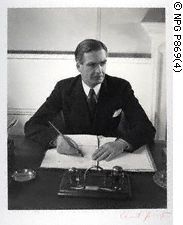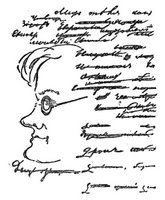PERSIA'S NUCLEAR POTENTIAL: AN UPDATE FROM DAVID ALBRIGHT'S ISIS
As those who know me quite well are aware of, I am not an enthusiast for science or things scientific. I have always had a great deal of sympathy for Lord Byron's 'Old King Ned Lud', and, have the traditional literary-humanist intelligentsia's contempt for science and scientists `a la Lord Snow's 'Two Cultures'. Regardless of that however, no one who has cared to follow the saga of Persia's pursuit of nuclear weapons, cannot fail to be impressed and thankful for the splendid research done by David Albright's Institute for Science and International Security (hereafter ISIS). They have been closely monitoring the latest developments in Persia and today they have published the newest accounting of how things stand. As per the contents of the report, which will appear below in an abbrevated form, suffice it to say that things most definitly do not appear to be on a favorable trend as it concerns Persia's quest. And, that it would appear the American Administration must come to some conclusions fast, as how it intends to proceed in this matter. The earlier myopic and utopian view that the mere announcement of a willingness to negotiate, as well as the enunciation of the 'respect agenda', et cetera, has not in fact done anything to force Persia off its course for nuclear weapons. If a new course is not arrived at by say the middle of October (and I personally do not see any possibilities of such occurring) then it may very well be the case, that the Netanyahu Cabinet, will throw caution to he wind, and engage in another example of Flucht nach vorn. With all the results that are implied by those horrible words from the summer of 1914. With all that being said, please peruse the report below.
Mysteries Deepen Over Status of Arak Reactor Project
David Albright, Paul Brannan, and Robert Kelley August 11, 2009
"Iran’s IR-40, or Arak, heavy water reactor, which has been under construction since June 2004, has not received as much attention as its gas centrifuge program. The reactor’s operation and potential to produce significant amounts of weapons-grade plutonium are years away, although this timeline is narrowing. Iran recently announced that it has mastered fuel fabrication for the Arak reactor at the Uranium Conversion Facility (UCF) at Esfahan. Last spring, President Ahmadinejad proudly unveiled a fuel assembly, which purportedly is for the Arak reactor. The fuel assembly on display by President Ahmadinejad is of a surprising shape for a small, 40 megawatt-thermal heavy water reactor and raises questions about whether it is indeed a fuel assembly for this reactor. One possibility is that the fuel assembly is not intended for the Arak reactor but was simply used for publicity purposes. In addition to questions about the fuel assembly, questions are also increasing about the status of the reactor’s construction and associated hot cells that could be capable of separating plutonium. Despite the growing questions, Iran has denied the IAEA the ability to scrutinize the Arak reactor, a step that the IAEA has said is inconsistent with Iran’s safeguards obligations. Iran refused to allow the IAEA to undertake a scheduled design information verification (DIV) visit to the Arak reactor and adjacent buildings on October 26, 20082 and again in April of 2009.3 The IAEA has also asked for updated design information about the reactor and its fuel, which was last provided several years ago. So far, Iran has refused to do so. It is imperative that Iran be more transparent about the Arak reactor, its associated hot cells, and fuel manufacturing facilities. By providing such transparency, Iran could go far to address concerns that the true purpose of the reactor is to make weapon-grade plutonium for nuclear weapons.
Did President Ahmadinejad reveal a fuel assembly for the Arak reactor?
Last spring, President Ahmadinejad led an Iranian press tour of the Fuel Manufacturing Plant at Esfahan during which he announced that the plant was operational (although images from this tour indicate that much equipment is missing). His visit was photographed and the pictures widely published on the Internet. In several photos, a fuel assembly is clearly visible. Figure 1 is a photo from that tour showing that fuel element. The IAEA is believed to have inspected this fuel assembly. The IAEA report for June 2009 states:
“On 23 May 2009, the Agency conducted an inspection at the Fuel Manufacturing Plant, at which time it was noted that, with the exception of the final quality control testing area, the process line for the production of fuel assemblies for the heavy water reactor fuel had been completed, and that one fuel assembly had been assembled from previously produced fuel rods.”
As can be seen in Figure 1, this fuel element is extremely long and thin. It closely resembles the fuel used in an RBMK (Reaktor Bolshoy Moshchnosti Kanalniy), Soviet-era reactor. Figure 2 shows a sketch of the RBMK element from a Russian web site and the similar characteristics are obvious, including the length, shape, types of pins and fitting on the ends. The picture also makes clear that this fuel assembly is not the fuel for the pressurized water reactor built by Russia at Bushehr, which has a hexagonal matrix of over 300 pins. The fuel assembly on display during the Ahmadinejad tour is odd for a relatively small heavy water reactor such as the Arak reactor. The RBMK is a commercial descendant of the large Soviet plutonium reactors built in the 1940s and 1950s. It is a graphite moderated reactor cooled by light water. The fuel rods are in a graphite matrix in pressure tubes. This is very different from the Arak reactor in Iran which uses heavy water as both the coolant and moderator. In addition, the RBMK fuel elements are enriched to about 3.5 percent; Arak’s fuel is expected to use natural uranium. RBMK reactors are designed to be refueled while they are operating, using a highly specialized and expensive refueling machine. This accounts for their great length. Perhaps, like the RBMK, the Arak reactor is designed to be re-fueled on-line. In this case, the fuel assembly would be removed from the core while the reactor continues to operate. This possibility, however, seems unlikely, given that the Arak reactor does not appear to have the elaborate water-cooled re-fueling arrangements necessary to safely transport this type of fuel from the reactor to a cooling pond.
Even if this fuel assembly is intended for the Arak reactor, why would Iran seek to build a heavy water reactor around such an inappropriate fuel design? One possible explanation for the unusual shape of a heavy water reactor fuel assembly is if Iran received a significant amount of help from Russia in building the Arak reactor. The U.S. government has reportedly asserted that the NIKIET institute in Moscow helped Iran build a heavy water reactor and sanctioned NIKIET in 1999 for this alleged assistance. The Russians responded that they only answered questions from Iran and did not provide any significant assistance beyond those answers. Based on this explanation, NIKIET could have provided information on RBMK fuel, with which it has extensive experience. NIKIET is a nuclear design institute that is very familiar with graphite-moderated rectors, such as the A and A1 production reactors that produced plutonium for the first USSR nuclear test. NIKIET went on to design the RBMK graphite-moderated power reactors and eventually the VVER family of pressurized light water reactors, including the Iranian Bushehr reactor. However, NIKIET has no known experience in heavy water moderated reactors of which only a few have ever been built in Russia. Another possibility is simply that Iran is not planning to use this fuel assembly in the Arak reactor. Rather, Iran could have displayed a RBMK uranium oxide fuel assembly for publicity purposes, allowing Ahmadinejad to proclaim that Iran had “mastered” this important step of the reactor’s fuel cycle. If this assembly contains uranium, it is likely the one inspected by the IAEA.
Is Iran developing the capability to make natural uranium metal fuel for the Arak reactor?
If the Arak reactor is to be used expressly for plutonium production, a more straightforward method is to use natural uranium metal fuel. If this fuel is clad in aluminum, it can be relatively easily processed in a radiochemical plant to extract plutonium. A reactor such as Arak would require tons of metal fuel per year if it is operated to produce weapons grade plutonium. One question is whether Iran is developing the capability to make uranium metal fuel for the Arak reactor. This possibility is suggested by a statement made by Mohammad Saeidi in his 2005 presentation to the World Nuclear Association meeting where he describes the characteristics of different parts of the Fuel Manufacturing Plant in Esfahan. It is potentially significant that the plant will produce the same amount of natural uranium metal as it does uranium oxide fuel for Arak. The IAEA needs to monitor this activity carefully.
What is the status of construction at the Arak reactor and associated hot cells?
Commercial satellite imagery reveals significant progress at the Arak site. An image from October 7, 2008 showed construction progress since February of 2007.6 A dome had been placed on top of the Arak reactor, construction of the cooling tower appeared completed, and many of the adjacent buildings, one of which contains a thick-walled hot cell facility, appeared externally completed as well.7 Iran’s refusal to allow design information verification visits hampers the IAEA’s ability to verify that the facility will not be used for plutonium separation, as it has declared. www.isisnucleariran.org











0 Comments:
Post a Comment
<< Home